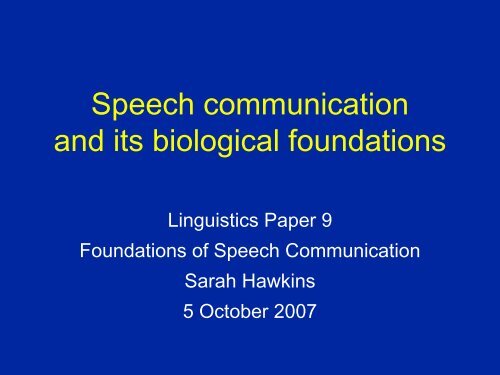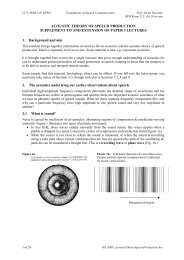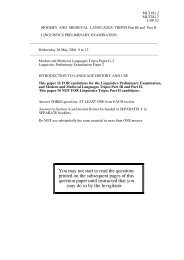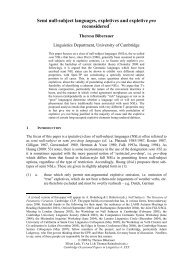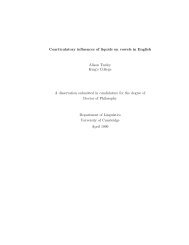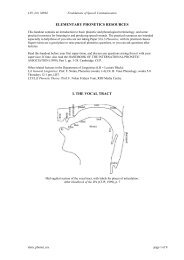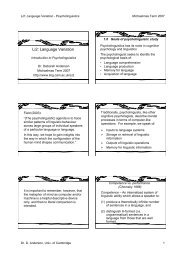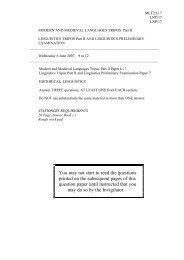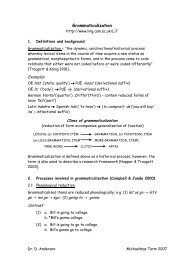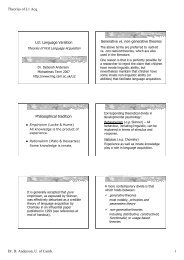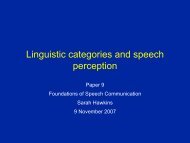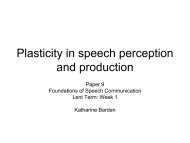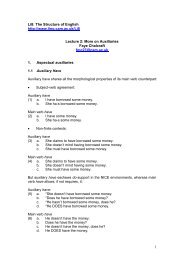Speech communication? Foundations?
Speech communication? Foundations?
Speech communication? Foundations?
- No tags were found...
Create successful ePaper yourself
Turn your PDF publications into a flip-book with our unique Google optimized e-Paper software.
<strong>Speech</strong> <strong>communication</strong>and its biological foundationsLinguistics Paper 9<strong>Foundations</strong> of <strong>Speech</strong> CommunicationSarah Hawkins5 October 2007
Aims• To think about what speech <strong>communication</strong> is• To place speech within its biological context,especially in terms of how speech may haveevolved as an adjunct to other developments• To indicate how understanding the biologicalspecialisation of speech can inform researchin areas like development and pathology
Communication?• Normally, involves more than one person• To “get something”:– for babies: goods, services, a nice feeling,or at least removal of nasty feelings(maintain biological equilibrium)– for older people: the same, though wenormally think of them as more complexe.g. “understanding, friendship, discussingideas, making decisions and contracts”
Communication:harmonyattunementMis<strong>communication</strong>:agitationloss of contact
conversation is part of <strong>communication</strong>
Controlling interaction• baby-parent interaction:– the baby controls what happens– a slow rhythm (entrainment, oscillations,cycles…..)– for social interaction (attunement)• mature speech can also be analysed in termsof rhythms with different frequencies– for speaking (e.g. jaw wags-syllables; pitchgroupings-phrases; conversational turns)– for listening (ditto; plus attention?)
Phonetic aspects of language shaped byinteractional considerations• Turn co-completiononce those cameras start flashing particularlywith the infants it puts them offbut when we walk out of the class nobodyknows what went on
Phonetic aspects of language shaped byinteractional considerations• Turn co-completiononce those cameras start flashing particularlywith the infants it puts them offbut when we walk out of the class nobodyknows what went onThere is nothing remarkable about thesestretches of coherent speech – except thatthey are jointly complished by two speakersrather than one
(2) Two Girls (5)Turn co-completionB: .hhh and we nod when he wants us to say yes (h)e[n ] .hhhA: [ye]ahB: we raise our hands when he wants to takea poll [.hh you knowA: [mmB: but when we walk out of the classA: nobody knows what went onCourtesy John Local
Talk which completes another’s turn is:1. not slower than the talk they complete (or than anyredoing of collaborative by coparticipant)2. not louder than the talk they complete3. rhythmically integrated with prior talk4. narrower in pitch range than the talk they complete5. closely pitch-integrated with prior talk6. designed with overall pitch contours which are thesame as those which can constitute complete turnsand “transition relevance places” (places someoneelse can successfully join in).
Turn co-completionCourtesy John Local
Phonetic contributions to themeaning of individual words• Traditionally– phonemes and allophones– everything else is ‘paralinguistic’ and/or‘prosody’• We will develop a different view during this course– Participants attend to the moment-by-momentevolution of complexes of parametric phoneticdetail– Such phonetic detail is no less ‘linguistic’ ormeaning-bearing than those details of thespeech signal that realise lexical items
PhonemesContrastive units of abstract phonology: unitsrelated to the sounds that distinguish words.Roughly like the sounds of an alphabetic writingsystem, but actually abstractions. Context freelettersnumber ofphonemesphonemespat 3 patsieve 3 sɪvthough 2 ðʊsix 4 sɪks
AllophonesPhysical phonetic differences, more or lesspredictable from word structure, that, if done“wrong”, do not change the meaning of the wordbut could make its pronunciation sound strangeContext-sensitivephonemes/pat/allophones[pʰaʔt]/spat/[spaʔt]/tap/[tʰaʔp]
Stand-alone “so” in American Englishholding-‘so’the same speaker continues with moreon-topic talktrailoff-‘so’there may be a change in who talksFor more details, see Local (2007) ICPhS http://www.icphs2007.de/(click on Plenary Speakers)
So, speech <strong>communication</strong> is• not all about identifying features, phones orwords• more about understanding meaning, andkeeping conversations going• grounded in biological structures andprocesses used for doing non-speech things
Biological substrates of speech• Synthesis of information from:– Studies of the evolution of structures used inspeech production– Genetics of speech/language disorders, and– Molecular biology of speech muscles, with anemphasis on muscle fibre types• Biological specialization for speech• Implications for understanding speechdevelopment and speech disordersSee Kent (2004)
Biological substrates of speech• development of lungs• walking upright (breath control)• descent of larynx and lengthening oflaryngopharynx (vocal tract shape)• space for the tongue to move• specialised types of muscles• genetic component• neural functioning (not covered in this lecture)
Development of lungs• the need to keep airways clear led todevelopment of a valve; from a simplesphincter muscle in the lung fish, this becamethe complex larynx in mammals• air movement + a valve can produce sound
Walking upright• affects breath control:homo sapiens and Neanderthals have largervertebral canals than other primates– required strong muscles, finely balanced, andthus enhanced neural control– vertebral canal enlarged to carry nerves tomuscles (diaphragm, ribcage (intercostals),legs); speech capitalised on this? Richard Wise– or, the enlarged canal reflects the demands ofspeech on the respiratory system? Ray Kent
Descent of larynx andlengthening of laryngopharynx• Between species: relative to where the soft palate (velum) is, thelarynx is lower in the adult human neck than in necks of non-humanprimates and human infants• Controversial...Courtesy Ray Kent
Descent of human larynx andlengthening of laryngopharynx• Within humans: the larynx is lower in the adult neckthan in the necks of infants (the adult neck is alsorelatively long). The descent starts in the first year of lifeSchematic mid-sagittalsection of part of infantvocal tract at 3, 6 and 9months3 months 6 months 9 monthsp = soft palate (roof ofmouth)e = epiglottis (part of thelarynx)From Kent and Murray,Journal of the AcousticalSociety of America 1982
BabyAdultSoft palate(velum)airfoodEpiglottisfoodair
Descent of larynx andlengthening of laryngopharynx• Infants and primates can engage their larynx and softpalate, shutting off their airway from the oral/foodpassageway. This allows them to breathe and drinksimultaneously; adult humans cannot.• The adult human configuration is poor for survival…• … but good for speech …
Implications for speech:space for the tongue to move• Non-human primate tongueis flat in mouth• Human tongue is curved,and the vocal tract is dividedinto two cavities with a rightanglebend• Tongue mobility may also behelped by a wide lower jaw[i][u]• This anatomicalconfiguration and tonguemobility permits articulationof the extreme vowels [i u][ɑ]
A classic theory based on theseobservations• Lieberman and Crelin (1971; Lieberman 1984)reconstructed Neanderthal vocal tract• Proposed: Neanderthals had a higher larynx thanmodern humans, which would not have permittedthem to articulate the point vowels• This and other speech inadequacies contributed totheir extinction(Neanderthals = hominids extinct c 30,000 years ago)
Problems with Lieberman’s theory1. Methodological problems with reconstruction of larynxposition on the basis of cranial anatomy (soft tissuesof vocal tract don’t leave fossils)2. Interpretation of acoustic consequences alsocriticised.3. More recent reconstructions suggest the potentialNeanderthal vowel space was as large as that ofmodern humans (Boe et al. J. of Phonetics 2002)4. Recent research suggests humans are not unique inhaving a descended larynx. Kent:– descent of the larynx, but not of the hyoid bone, has been shown ininfant chimpanzees. Was there a two-stage process?1. larynx falls relative to the hyoid bone2. hyoid bone falls relative to mandible (lower jaw), in humans only
Low larynxes…• Temporary descent duringvocalisation in many mammals(dogs, pigs, goats, monkeys;Fitch 2000 Phonetica)• Permanent descent in red deer,accompanied by furthertemporary descent duringvocalisation (Fitch and Reby2002)• Possibly for sound propagation;more likely, to exaggerate bodysize (<strong>communication</strong> as power;bluffing over honesty?)Break forred deer movieSource: Tecumseh FitchUniversity of St Andrew’shttp://www.st-andrews.ac.uk/~wtsf/
Therefore…(so)Is it“not our anatomy, but our control of our anatomy”that makes human vocalisation special?
Specialization of speech musclesThe muscles of the speech organs havedistinctive fibre composition, which affectse.g. the range of contraction speeds andresistance to fatigue.This makes their behaviour very differentfrom ordinary skeletal muscle, and highlysuited to their specialized roles in phonationand articulation
Specialization of speech musclesJawmusclesand palatalmusclesare fatigueresistantCourtesy Ray Kent
Specialization of speech musclesMuscles oftongue andvelum containfibres that helpwith fast andflexibleactions forpositioning andshaping thetongueCourtesy Ray Kent
Specialization of speech musclesVocalis muscle (partof vocal folds)contains slow tonicfibres capable ofsustained, precisecontractions. It is alsofatigue resistant.This may be a uniquehuman specializationfor speech.See Kent (2004)
Specialization of speech muscles• May help explain aspects of how speech developsand responds to aging, brain disease, andneurological treatment. E.g.:• Medical treatments that normally improve nonspeechmotor control sometimes don’t improvespeech, and may make it worse. E.g. dopaminetreatments for Parkinson’s disease.
Genetic component: FOXP2 gene• A protein, FOXP2, affects normal developmentof speech and language– chimpanzees lack it– it seems important in songbirds• Kent (2004): speech and language may berelated to genes on (at least) 7 chromosomes– impaired nonword repetition arises from mutations inany of 3 chromosomes (3, 7, 16)• Family KE: FOXP2 mutation on chromosome 7– family members with this mutation have SpecificLanguage Impairment (SLI) including impairedrepetition of nonwords, and brain abormalities
Summary• <strong>Speech</strong> and language comprise one part ofhuman <strong>communication</strong>• <strong>Speech</strong> may exploit human anatomy andphysiology, or the organs may have evolved tosupport speech – we do not know• We are only beginning to gather genetic data• Neural substrates and hearing are alsoimportant; will be discussed in later lectures• We have discussed speech evolution more thanlanguage evolution, for which there is evenmore controversy, and less evidence
ReadingConversation:LOCAL, J.K. (2007) Phonetic detail and the organisation of talk-in-interaction. Proc.ICPhS. http://www.icphs2007.de/ (Click on “Plenary Speakers”)LOCAL, J.K. (2003) Variable domains and variable relevance: Interpreting phoneticexponents. Journal of Phonetics, 31, 321-339.Evolution etc: Supervision reading list section 11, especially:KENT, R.D. (2004) Development, pathology and remediation of speech. In Slifka,J., Manuel, S., and Matthies, M. (eds.) From Sound to Sense: 50+ Years ofDiscoveries in <strong>Speech</strong> Communication. CD. B148-B163. [RB]and via http://www.rle.mit.edu/soundtosense/conference/pages/invited.htmFITCH, W.T. (2000) The evolution of speech: a comparative review. Trends inCognitive Science 4: 258-267.CHRISTIANSEN, M.H. and KIRBY, S. (2003) Language Evolution. Oxford: OxfordUniversity Press. Chapters by Fitch and Hauser, Lieberman.Tecumseh Fitch’s website is fun: http://www.st-andrews.ac.uk/~wtsf/


